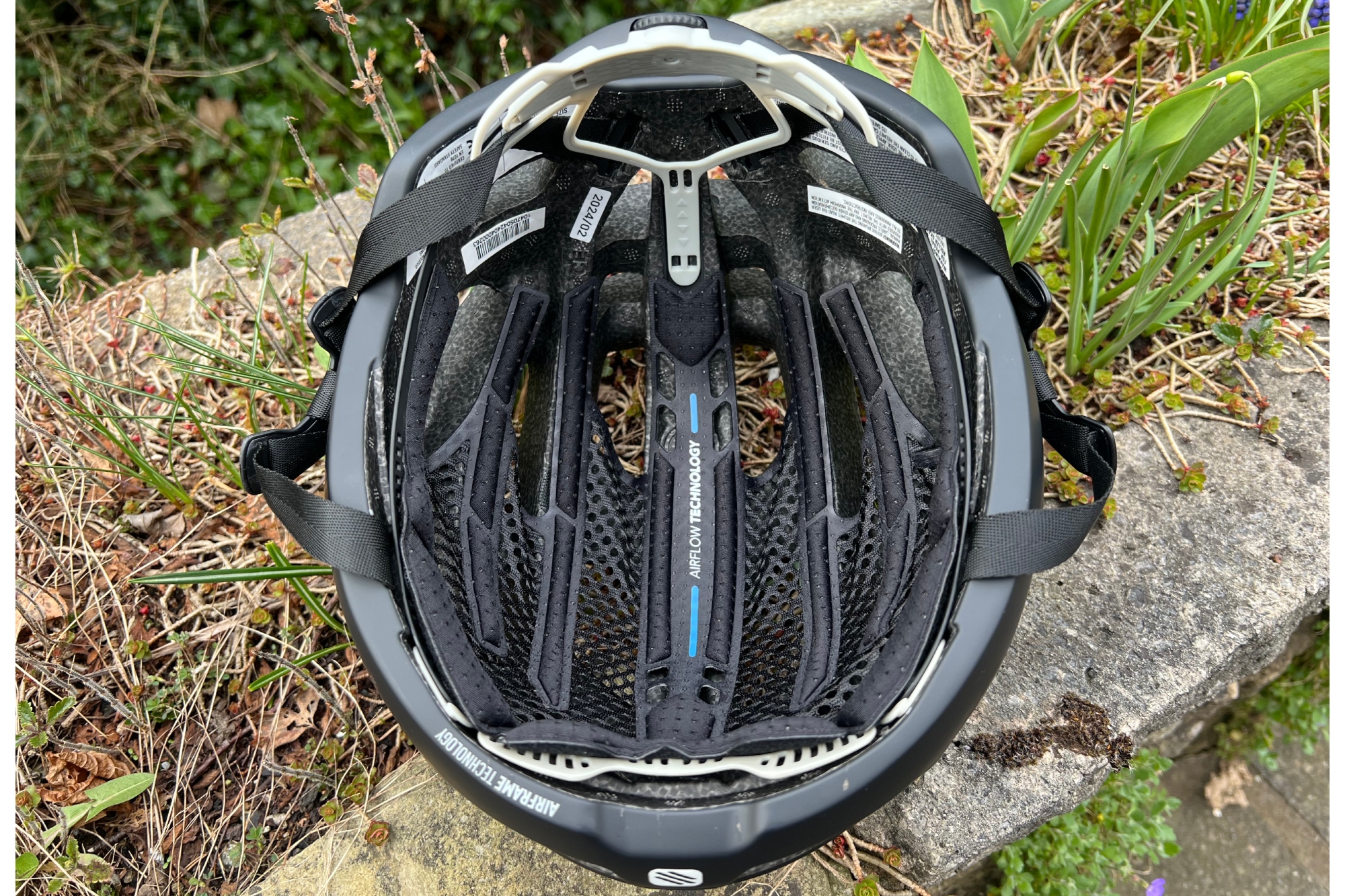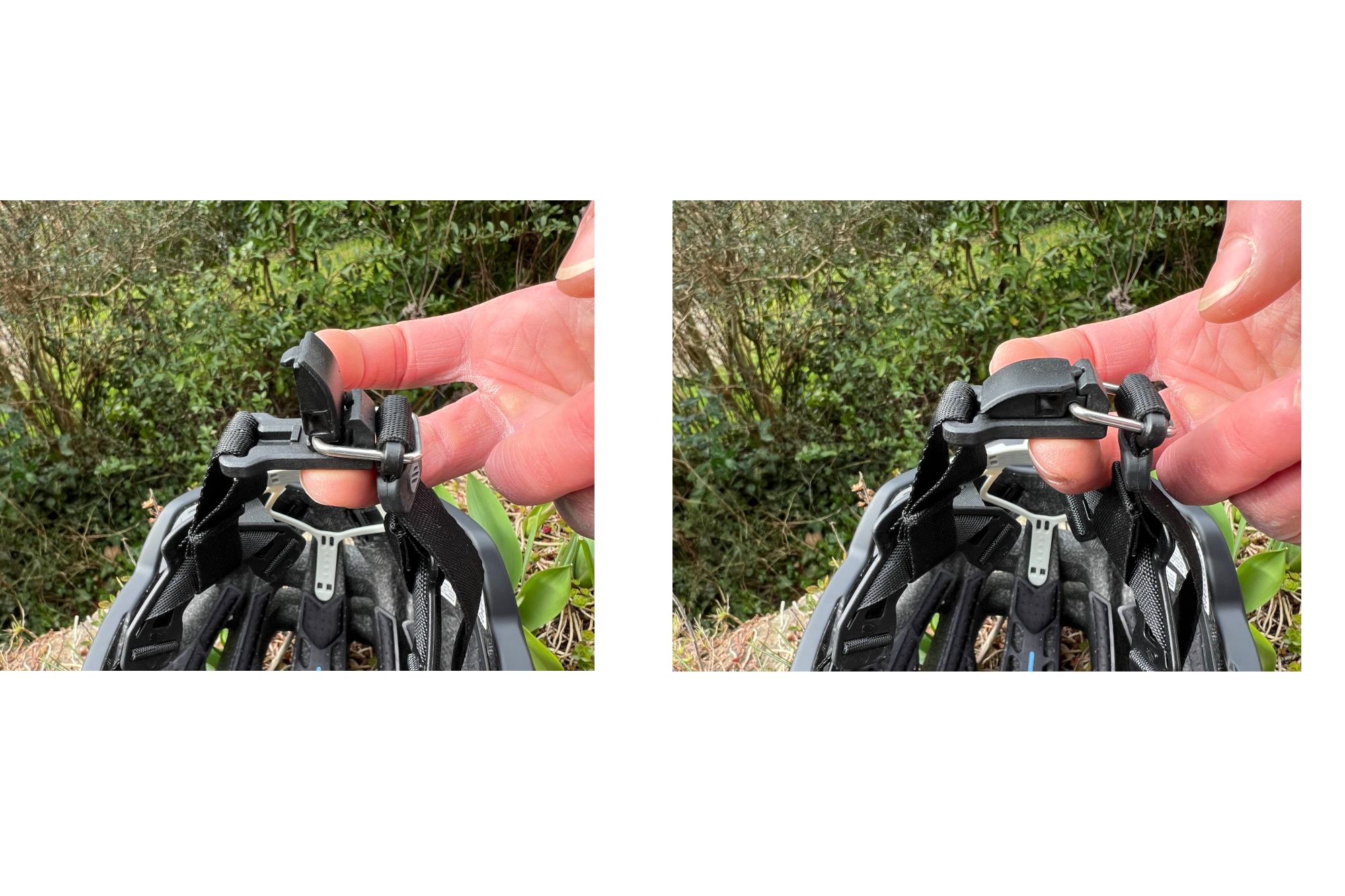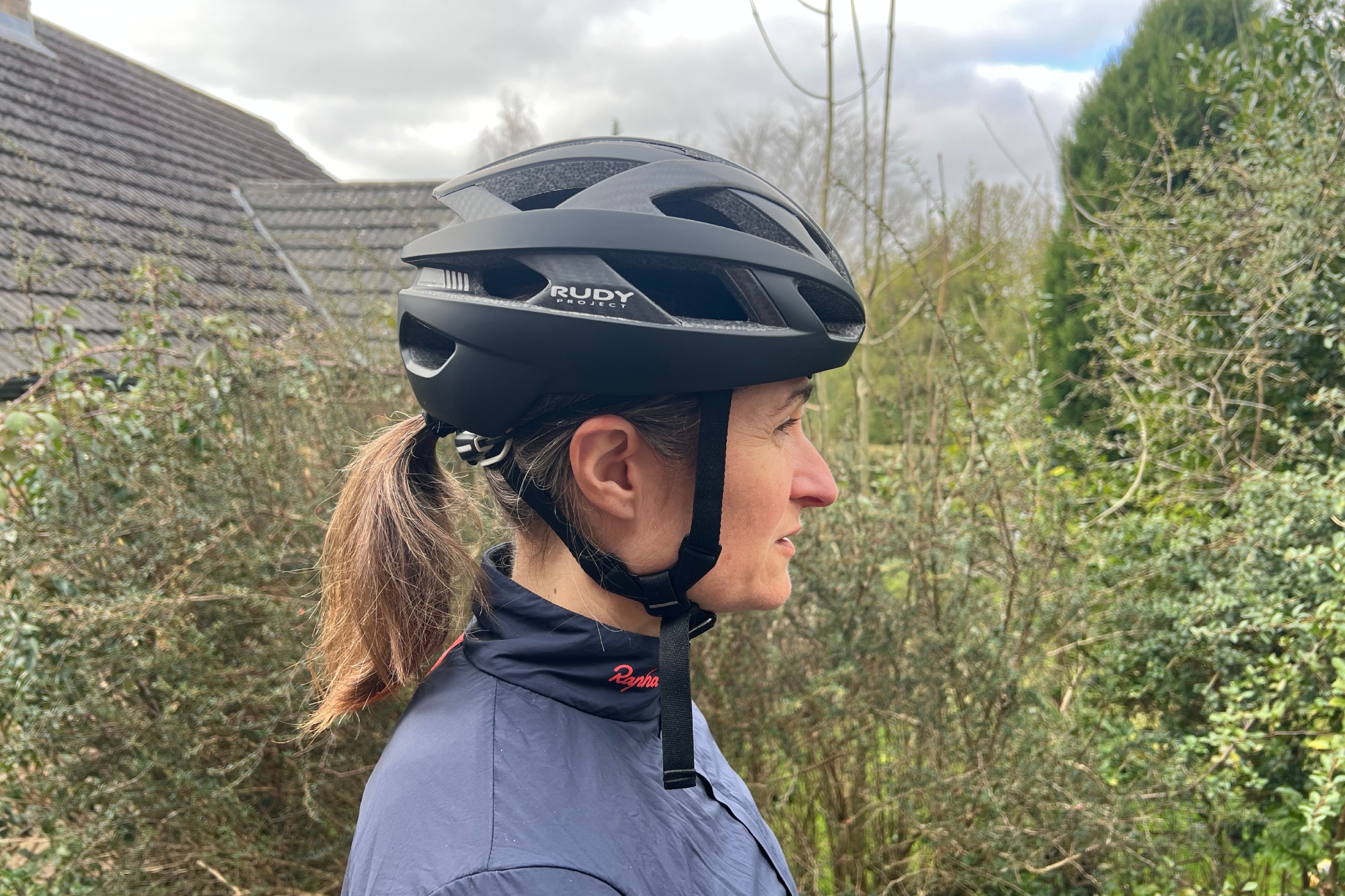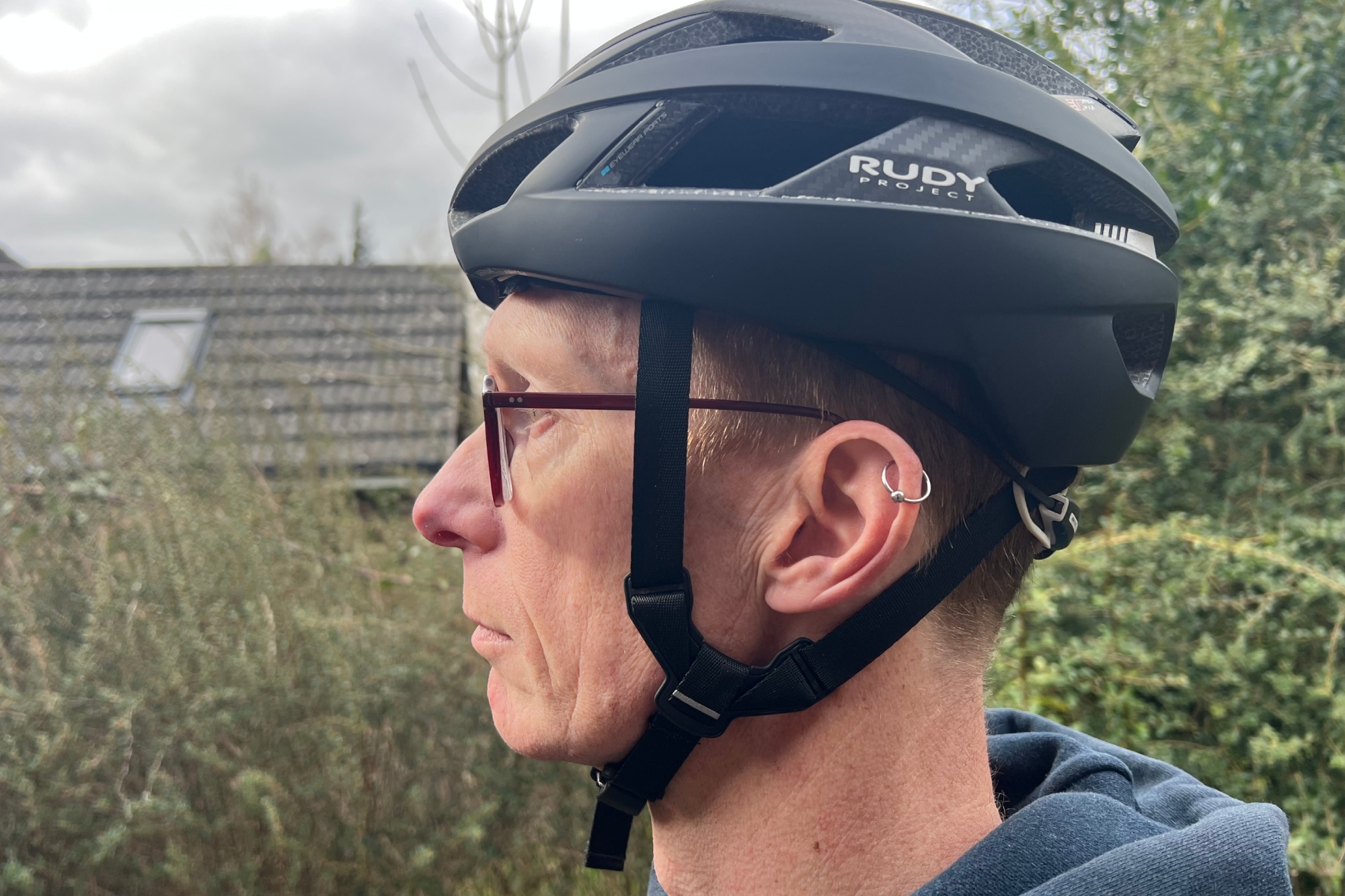
The current trend for aero-shelled helmets has been a struggle for me. I have a rather small head, and I'm not that fussed about outright speed these days. Even when wearing the best of the contemporary helmets, I fear being mistaken for a Belisha beacon, and worry constantly about someone wanting me to assist them in crossing the road.
So when the Rudy Project Rebel road bike helmet arrived, I was immediately intrigued. It had vents—and lots of them—and it was also compact. Could this become my new riding buddy?

Construction
While Rudy Project may boast that the Rebel's core design is the Carbon Kevlar panels, ESP (Expanded Polystyrene) foam is at the heart of the helmet's construction. This isn't to say it's bad; ESP is doing the important work of protecting our heads in most helmets, because it excels at absorbing single, high-energy impacts by crushing and dissipating the force—perfect for a bike helmet.
Carbon Kevlar comes into play here, in the form of panels that enable the Rebel to be lightweight and highly ventilated, whilst also ensuring a high degree of structural reinforcement.
According to NIH, Carbon Kevlar "combines the properties of the two types of fibres, offering high levels of strength and stiffness, as well as high impact strength." This is an excellent combination in the manufacture of helmet shells.
Comparing vent numbers against the Smith Optics Trace MIPS, which racks up and impressive 18 vents, and the Rapha + POC Ventral Lite helmets, with 20 vents, the Rudy Project Rebel scores even higher, with 22 vents and six internal airflow channels.
However, when it comes to weight, the Rebel is by far the heaviest of the three, at 266g for a size small/medium. This is less than 30g lighter than the Smith Optics Trace MIPS, at 294g, but nearly 100g more than the Rapha + POC Ventral Lite, at 170g.
The Smith, has the MIPS safety system, a feature that always adds weight to a helmet, while the Rebel does not. So to find this is heavier, is a surprise.
Instead of MIPS, which is designed to protect the brain from rotational forces, Rudy Project has chosen an alternative construction method, which, according to the brand, means the Rebel meets regular helmet safety requirements with CE EN 1078 certification, and does also pass the RP Rotational Impact Test. Rudy Project claims that this advanced test protocol uses the BrIC index, which in this helmet, minimises the risk of brain injuries from rotational impacts sufficiently.

Rudy Project also says that in this design, they've combined their Fid Lock magnetic closure with what they refer to as their RSRMicro11 retention system, making sure the helmet stays put, safe and secure where it should be in case of an accident.
Elsewhere, the brand has also aimed to enhance rider comfort. The helmet strap includes an Ergo Divider under-ear adjustment system to ensure a stable fit and reduce strap flap at high speeds. Front eyewear docking ports are also included for ease of glasses storage.
The Ride

In terms of fit and overall performance, this is a great helmet; the weight whilst not as low as alternatives doesn't matter much as it is hardly noticeable, and I'm sure I will appreciate the ample and welcome ventilation in warmer UK temperatures. Likewise, whilst the supplied insect net isn't really needed this early in the season, and I might prefer to remove it so I can scratch my head a little more easily at this time of year, I would imagine I'll be very grateful for it during peak bug season!
Here at Cycling Weekly, we don't have a wind tunnel and no way of performing destructive testing, short of falling off, which is a length I'm not prepared to go to for the lovely readers of CW, so we'll need to take Rudy Projects' claims on both at face value, though it's noted that the tests they have performed have been independently verified.
Despite crossing two sizes, this helmet didn't feel excessively large on my head. It's easy to wear a skull hat underneath for cooler weather, and I find the rear retention system easy to tighten or loosen on the move.
However, the big issue with the fit is the straps, which make me feel somewhat self-conscious when wearing the Rebel. While I can ensure a close and secure fit under my chin, I can't shorten the side straps, and the Ergo Divider under-ear adjustment system sits on my jaw.

And, I'm not the only one who will suffer from this issue. For robustness, I asked my other half, who has a larger and longer head to try on the helmet. Still, the Ergo Divider sits too low. Having checked and re-checked, the straps appear to have only one point of adjustment to shorten the straps. The forward and aft options that are there on the Ergo Divider also don't let me take up any of the excess slack in the strap.
I was concerned enough that I referred the issue to the Rudy Project team. I explained the issue I'd encountered, and asked whether or not the issue could impact the helmet's safety or performance. I'm yet to hear back, but as soon as I do, I'll update this review.
I also found the Fid Lock closure system difficult to use. After weeks with the helmet, I still can't connect the strap under my chin without my ten-year-old's help. The thought of removing the helmet during a café stop or after a ride triggers mild claustrophobia. I recognise that there's probably impressive engineering involved in this helmet, but if it means I can't be confident fitting the helmet on my own, then I question its benefits. The commonly used clip systems used in most other helmet designs work better. So I'm baffled as to how or why they've gone their own way, if it doesn't improve things.
Value and conclusion
In a helmet market full of aero hard shells, it's great to see Rudy Project bring an alternative to market. Weight-wise compared to its peers it could be lighter, but it's barely noticeable on your head, it has ample ventilation and still provides a comfortable ride.
I appreciate the brand's attempt to go its own way, designing some – on paper –pretty neat homegrown features, but I'm not entirely clear on what these contribute. The limited strap length adjustability is a real chore, especially when the price point places the Rebel in direct competition with very accomplished set ups like the Smith Optics Trace MIPS and Rapha + POC Ventral Lite. The former offers the gold standard of helmet safety features, while the latter is lighter.
There's still a lot going for Rebel, and there's no strong reason not to buy it, especially if like me you prefer this style of helmet, but in my view it doesn't stand out sufficiently to make real waves, especially at the £270 / $TBC price point
Specs
- Safety Features: CE EN 1078 certification and a pass in the RP Rotational Impact Test.
- Sizes: S/M, L
- Colours: Black, White, Red
- Weights: 250g for S/M







